
- •Introducing Ubuntu
- •About Open Source
- •Free Software Movement, Open Source and Linux
- •The Free Software Movement
- •The Open Source Movement and Linux
- •About Ubuntu
- •The Ubuntu Promise
- •Ubuntu Versions
- •Ubuntu Derivatives
- •Ubuntu Development and the Community
- •Ubuntu and Microsoft Windows: Key Differences
- •Installation
- •Applications
- •Lesson Summary
- •Review Exercise
- •Exploring the Ubuntu Desktop
- •Ubuntu Desktop Components
- •Changing the Default Language
- •Creating a User Account and Fast User Switching
- •Adding/Removing Applications
- •Desktop Effects - Compiz Fusion
- •Lesson Summary
- •Review Exercise
- •Lab Exercise
- •Using the Internet
- •Connecting to and Using the Internet
- •Network Manager
- •Using a Cable Connection
- •Using a Wireless Card
- •Browsing the Web
- •Using an RSS feed reader
- •Liferea Newsreader
- •Using Evolution Mail
- •Instant Messaging
- •Making Phone Calls Using Softphones
- •Using Ekiga
- •Skype
- •Lesson Summary
- •Review Exercise
- •Lab Exercise
- •Performing Basic Spreadsheet Tasks
- •Performing Basic Drawing Operations
- •Creating and Editing Formulae
- •Additional Applications
- •GnuCash Accounting
- •Lesson Summary
- •Review Exercise
- •Lab Exercise
- •Ubuntu and Games
- •Installing Games on Ubuntu
- •Installing a Game from a Repository
- •Playing Ubuntu Games
- •Playing PlanetPenguin Racer
- •Playing Other Popular Games
- •Installing Wine
- •Playing a Microsoft Windows Game on Ubuntu
- •Lesson Summary
- •Review Exercise
- •Lab Exercise
- •Customising the Desktop and Applications
- •Introduction
- •Customising the Desktop
- •Changing the Background
- •Customising the Theme (Buttons & icons etc)
- •Customising a Screensaver
- •Customising the Screen Resolution
- •Working with Files Using Nautilus
- •Features of Nautilus
- •Nautilus
- •Package Managers
- •Types of Package Managers
- •Using Add/Remove Applications
- •Using Synaptic Package Manager
- •Installing a Single Package File
- •Installing/Uninstalling Debian Packages
- •Software Repositories
- •Software Repository Categories
- •Adding New Language Settings
- •Lesson Summary
- •Review Exercise
- •Lab Exercise
- •Making The Most of Images and Photos
- •Introducing Graphics Applications
- •Viewing and Managing Photos with F-Spot
- •Viewing Photos
- •Organising Photos
- •Removing Red Eye
- •The GIMP
- •Drawing with Inkscape
- •Installing Inkscape
- •Creating Vector Graphic Images Using InkScape
- •Using a Scanner
- •Checking Scanner Compatibility
- •Scanning an Image
- •Lesson Summary
- •Review Exercise
- •Lab Exercise
- •Playing Music and Videos
- •Legal Restrictions
- •Playing Music Files
- •Playing Music using Rhythmbox
- •Playing and Extracting Audio CDs
- •Playing Audio CDs
- •Extracting Audio CDs
- •Burning Audio CDs
- •Playing Proprietary Multimedia Formats
- •Using an iPod
- •Playing Music Using an iPod
- •Creating and Editing Audio Files
- •Creating Audio Files
- •Editing Audio Files
- •Playing DVDs
- •Playing DVDs in Totem Movie Player
- •Backing up DVDs
- •Playing Online Media
- •Watching Videos in a Web Browser
- •Editing Videos
- •Editing videos using Pitivi video editor
- •Lesson Summary
- •Review Exercise
- •Lab Exercise
- •Ubuntu Help and Support
- •Introduction
- •System Documentation
- •Online Documentation
- •Community Support
- •Mailing Lists
- •Web Forums
- •IRC Channels
- •LoCo Teams
- •The Ubuntu Team Wiki
- •Launchpad
- •Launchpad Technical Answers
- •Launchpad Bug Tracker: Malone
- •Shipit
- •The Fridge
- •Paid For Commercial Services
- •Professional Support Services from Canonical
- •The Canonical Marketplace
- •Lesson Summary
- •Review Exercise
- •Partitioning and Booting
- •What is Partitioning
- •Creating a Partition
- •Installing GParted by Using Synaptic Package Manager
- •Partitioning Using Gparted
- •Boot-up Options
- •Changing the Default Operating System at Boot
- •Lesson Summary
- •Review Exercise
- •Lab Exercise
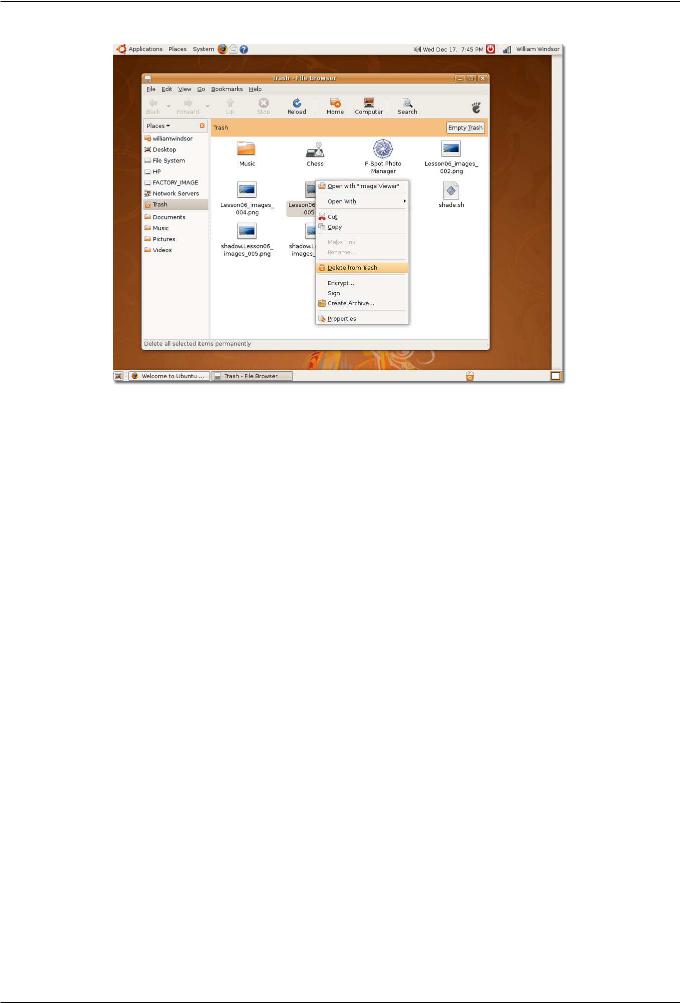
Ubuntu Desktop Training
25 / 335
Figure 2.23: Deleting Items from Trash
2.2 Changing the Default Language
Nice to Know:
Ubuntu supports more than 100 languages. You can set the default language of your computer either during the installation of Ubuntu or at a later stage.
To change the default language during the installation, select the required language when prompted.
1.On the System menu, point to Administration and click Language Support. The system prompts you to install language support if updates are available for your selected language.
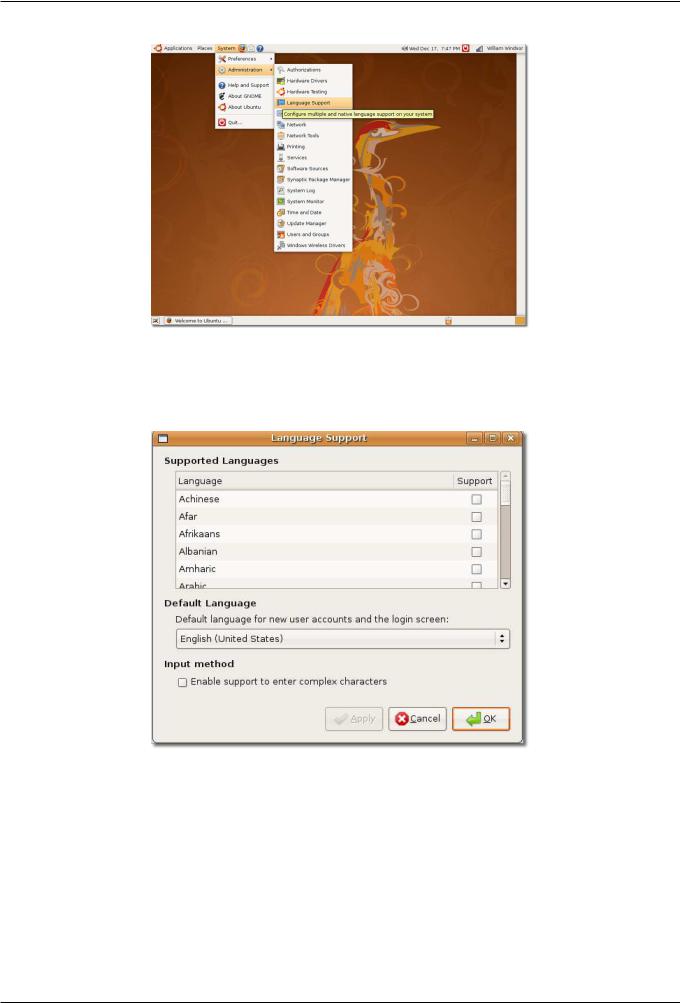
Ubuntu Desktop Training
26 / 335
Figure 2.24: Configuring Language Support
2. Click Install to continue. On completing the updates, the Language Support dialogue box opens.
Figure 2.25: Installing Language Support Updates
3.In the Language Support dialogue box, from the Supported Languages section, select the check box for the language you want to use for support functions in Ubuntu.
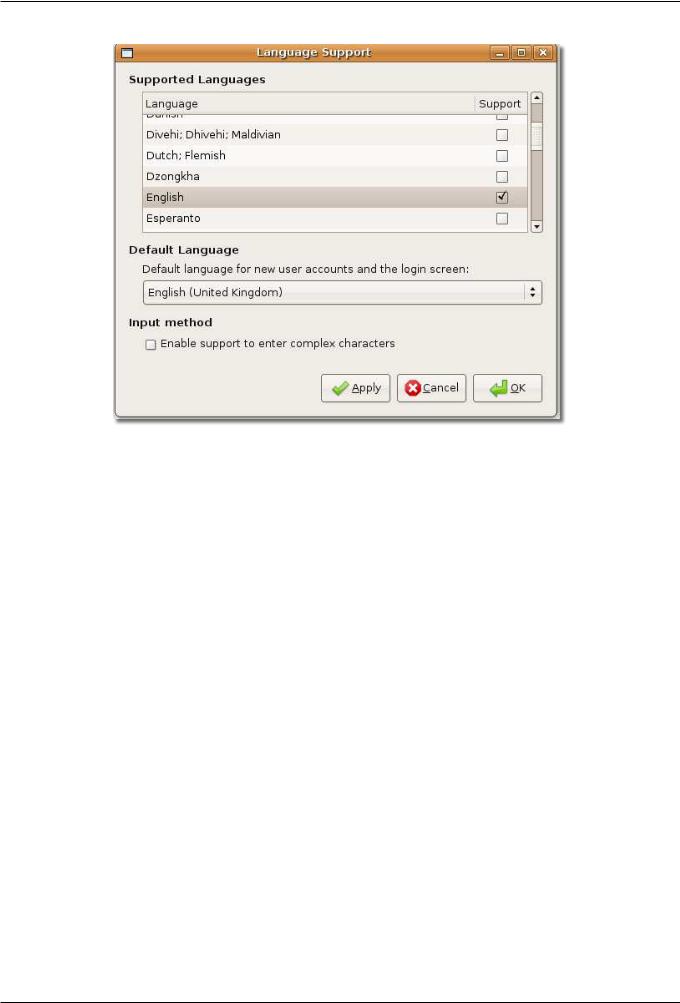
Ubuntu Desktop Training
27 / 335
Figure 2.26: Installing Default Language Support
4.Click Apply and then click OK. Ubuntu downloads and installs the necessary packages on your computer. The language you selected will now appear in the Default Language box.
5.Select the language that you want set as default, and click OK.
6.For the changes to take effect, log off and then log on again.
You can change the language as many times as you would like and this can depend on your location. For example, changing the language to Russian may be a nice touch when presenting in Russia during a business trip.
2.3 Creating a User Account and Fast User Switching
You may have multiple users who want to access your system. In this case, there is a risk of data being manipulated or corrupted by other users. To prevent this from happening, you can create user accounts for each individual who wants to use your computer, giving each user an individual account with personalised user settings. For example, it is useful to give children their own accounts on the computer to prevent then from changing your settings or accessing unsuitable files and applications..
1. On the System menu, point to Administration and click Users and Groups. The User settings dialogue box appears.
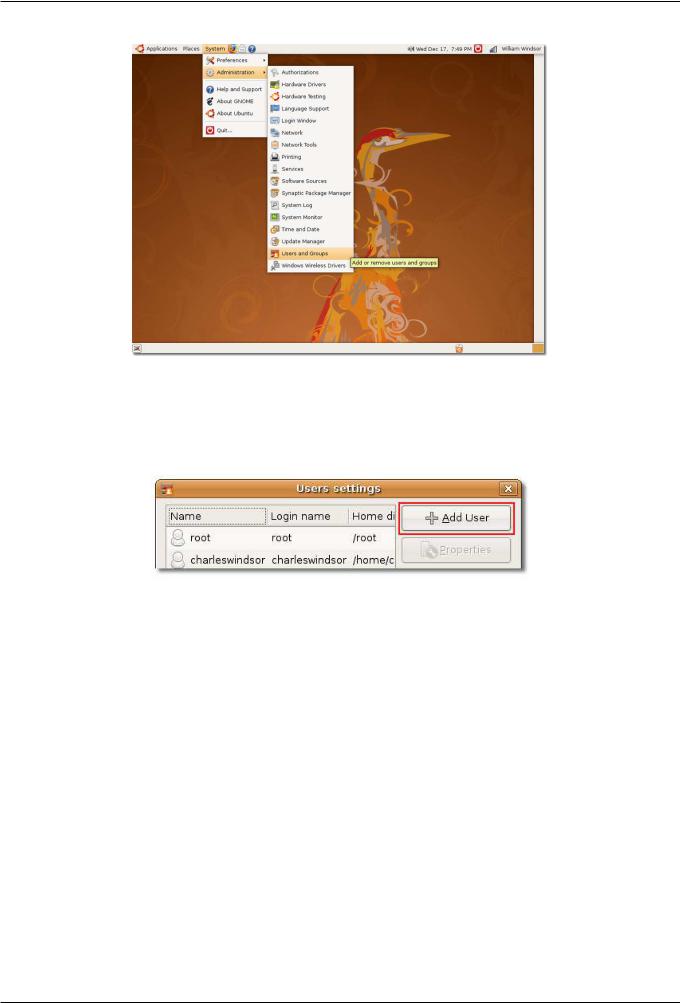
Ubuntu Desktop Training
28 / 335
Figure 2.27: Adding/Removing Users
2.In the User settings dialogue box, click Add User to add a new user account on your computer. The New user account dialogue box opens.
Figure 2.28: Adding a User
3.Specify the user accounts’ basic settings, contact information and password information in the New user account dialogue box.
(a)Type the name with which you want to log on to your computer in the Username box.
(b)Type your full name in the Real name box.
(c)Select your user type from the Profile box.
(d)Type your office location in the Office location box.
(e)Type your work phone number in the Work phone box.
(f)Type your home phone number in the Home phone box.
(g)Type the password for your user account in the User password box.
NOTE:
This information is for record keeping only, and other users cannot view it.
Click Close to save the settings.
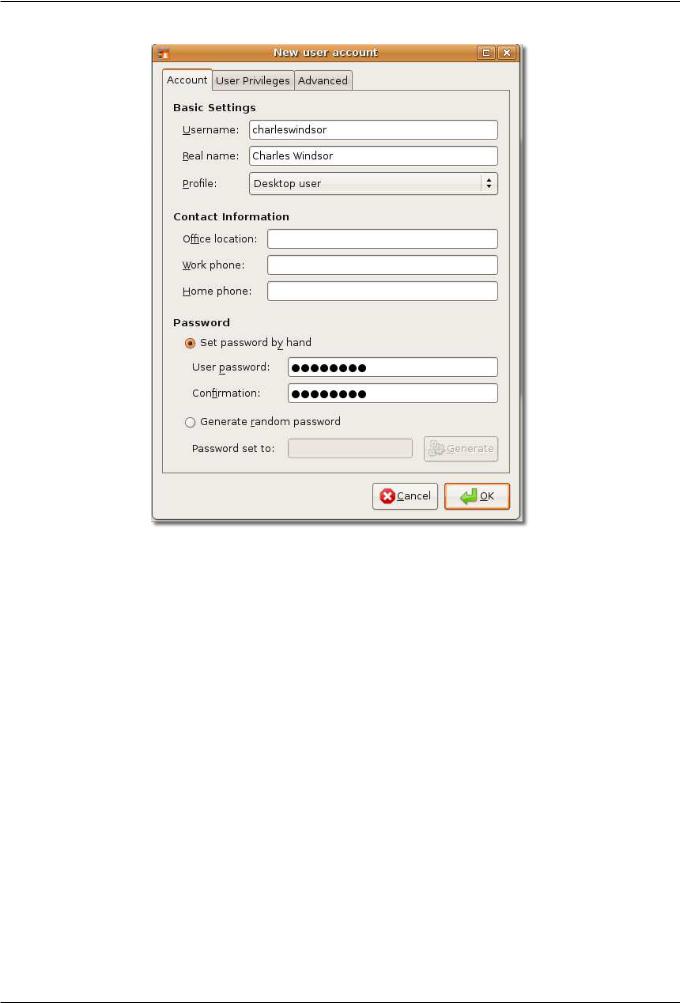
Ubuntu Desktop Training
29 / 335
Figure 2.29: Configuring New User Account
4.A new user account will be displayed in the User settings dialogue box. This dialogue box displays the new user’s full name and login name. It also tells you the location of the new user account created.
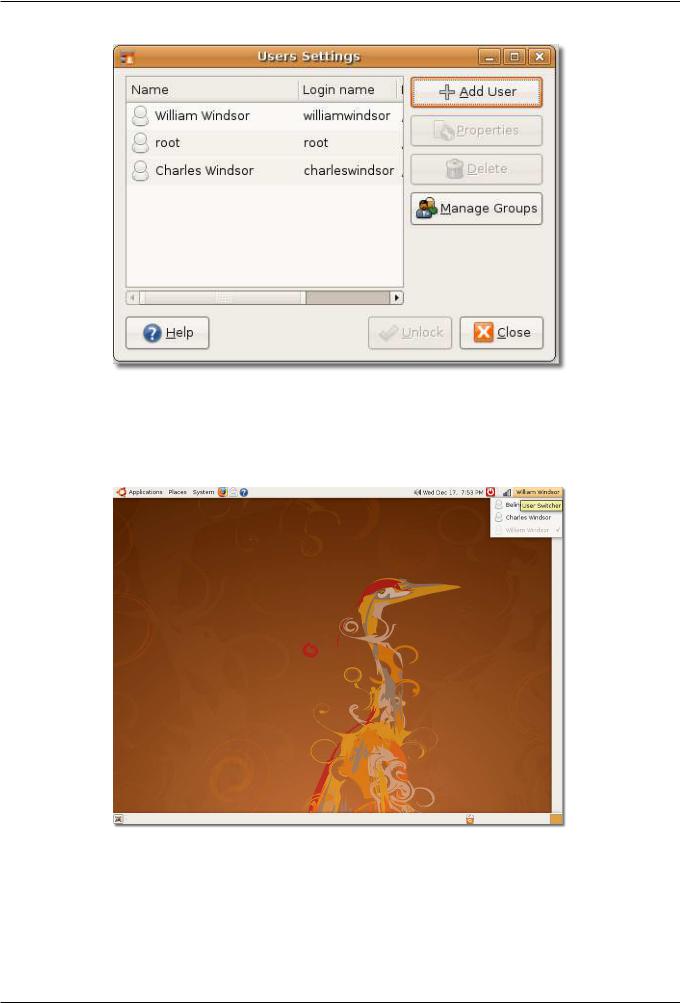
Ubuntu Desktop Training
30 / 335
Figure 2.30: The New User Account
Now, if you click the fast user switch icon, there will be two users displayed and the current user logged on to the computer will be marked.
Figure 2.31: Switching Users
This feature prevents you from logging off and logging on all the time to switch users. It allows multiple users to switch quickly while staying logged on. By simply clicking the fast user switching icon, a list of the user names appears. Select the user name and you will be directed to the logon screen. Type the user name and password, and you will be on a desktop of the new user.
